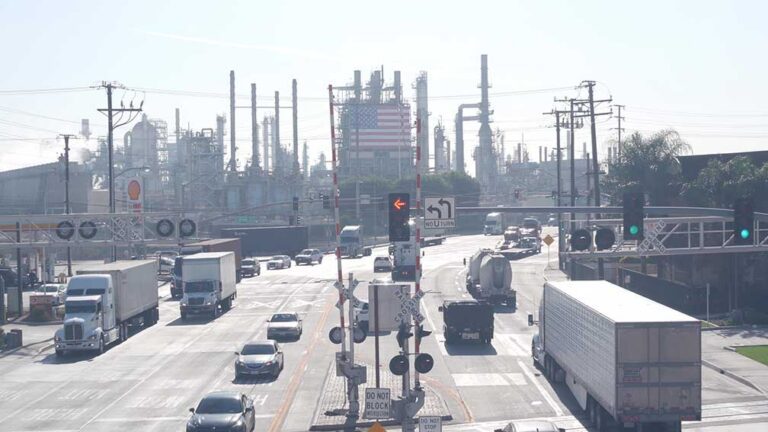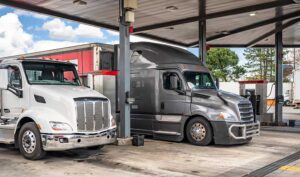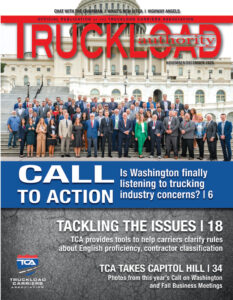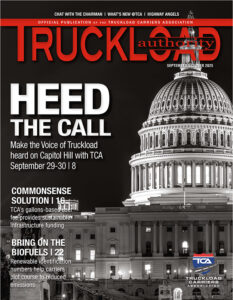Written by Dave Williams, Chairman, Truckload Carriers Association
Everyone is familiar with the Chinese proverb, “A journey of a thousand miles begins with a single step.” The rest of the story, according to a Google search, is that it takes over 2 million steps to complete that thousand-mile journey.
There is no avoiding the rest of the steps. However, that is exactly what environmental regulators are trying to do. Current regulatory proposals and discussions are attempting to ignore time-proven, necessary developmental paths and jump straight to the final destination: zero-emissions vehicles.
Regrettably, the trucking industry’s developmental path to emissions reductions is not widely understood or celebrated. This journey really got serious in the late 1990s and continues today. The focus historically has been placed on nitrogen oxide (NOx) and particulate matter (PM) emissions. More recently, with much of the world focused on climate change, the focus has shifted to carbon dioxide (CO2) and other greenhouse gases (GHG).
If we review what the industry has accomplished in the past few decades, working in partnership with environmental regulators, we find some incredible accomplishments. In the past 20 years, the industry has reduced NOx emissions by 95% (4g/HP-hr to 0.2g/HP-hr). By 2027, NOx emissions will drop an additional 83%.
When combined, these reductions represent a drop of over 99% in NOx emissions. In other words, we will have virtually eliminated NOx. Remember that number; we will need to come back to this.
PM emissions have a similar story. As an industry, we have reduced PM emissions by 99%. The biggest step came in 2007 with the addition of the diesel particulate filter. Again, this is an emissions component we have virtually eliminated.
To understand CO2 emissions, we must recognize that CO2 emissions are directly tied to fuel economy. Over the past 20 years, the truckload industry has gone from fuel economy that averaged around 6 mpg to more fuel-efficient tractors that regularly top 7.5 mpg. This conservative difference yields a CO2 emissions improvement of 25%. That’s strong progress. You could even argue that the CO2 and fuel economy improvements are greater, but at a minimum, these results are directionally accurate.
Improvements in these three primary emissions were won through hard-fought incremental improvements in aerodynamics, rolling resistance, diesel combustion efficiency, emissions aftertreatment, and exhaust gas recirculation, among other strategies. The implementation of some of these technologies was a little painful, but we figured it out together. We worked together to bring about solid results.
Fast-forward to today. The industry is being asked to abandon this hard-fought development path and jump all the way to zero-emissions vehicles (even though they are not truly zero emissions, but that is a conversation for a different day).
Let’s be clear: If zero-emissions vehicles were a functionally and economically viable option, we would embrace them. Who wouldn’t want a tractor that gets the job done and has zero impact on the environment? Currently, however, zero-emissions tractors require a lot of work before they’re viable for transporting the greater portion of freight in the U.S. There are well-documented challenges associated with the current offerings, including cost, weight, range limitations, charging/fueling infrastructure, and the readiness of the nation’s electrical grid.
Again, we would embrace these technologies if not for significant hurdles that must be overcome. Unfortunately, if we just say no to zero emissions vehicles, we aren’t considered part of the solution and are at risk of being left out of the discussion.
Fortunately, we do have viable solutions:
Diesel
This will be unpopular with environmentalists, but the fact is that there is still a path for diesel. Diesel fuel is an energy-packed dynamo that has served the industry well for many decades. We have already effectively reduced NOx and PM using diesel technologies. When we look at CO2, there is a clear, continued path for significant reductions.
These reductions would come partly through improvements in engine efficiency, but they would also come from the fuel itself. Progress is being made in the production of renewable diesel. Some manufacturers have documented up to a 75% reduction in GHG emissions, which includes CO2.
This is not the blended biodiesel many are familiar with; this is pure wizardry in chemistry that reorganizes molecules to reshape organic material into diesel fuel. This is a very compelling technology to watch. Many fleets are already running some of this fuel and may not even know it. Truck stops have begun blending this new fuel with traditional diesel and are offering it at the pump today.
Renewable Natural Gas
Renewable natural gas (RNG) actually boasts a negative carbon score. This is achieved as manufacturers repurpose organic material that would otherwise erode and create gases that are harmful to the atmosphere. Instead of allowing this decomposition to impact the atmosphere, these gases are captured and used as fuel (think cow manure and landfills). At one point, natural gas was the hottest thing on the planet; then it faded from the spotlight when diesel fuel costs dropped and fleets were unwilling to deal with some of the nuances associated with the fuel. Taking another look at it today, a new 15-liter natural gas engine has just been released and diesel prices are sky-high. As an alternative to electric, this technology continues to hold promise.
Hybrids
The description “hybrid” can mean a lot of things — it could be a diesel-electric, or some other form. The interesting thing about hybrids is that you can go fully electric within a geofenced area (i.e., an environmentally sensitive area like the Port of Los Angeles) and then go back to a clean-burning diesel when you leave that area.
Hybrids potentially solve several of the issues that plague the electric-only version for the trucking industry. It is interesting to watch the auto manufacturers’ experience in the process of converting to electric cars. They are starting to talk openly about consumers’ acceptance of hybrids over pure electric vehicles. Consumers appreciate the flexibility of hybrids. This is one of the biggest hurdles associated with heavy-duty electric tractors — the lack of flexibility. Hybrids are a natural solution to consider.
Emissions Reductions via Fleet Replacement
At the American Trucking Associations’ (ATA) 2023 Management Conference & Exhibition, ATA President Chris Spear walked through some interesting data. He noted that roughly half of the tractors operating in California are equipped with 2010 model year engines or older. By replacing a pre-2010 tractor with a new tractor, the calculated emissions reductions amount to a whopping 83%. That is significant and cannot be ignored.
It should also be noted that the replacement tractor has a diesel engine. Normally, when we review proposed emissions regulations, we compare the new proposed emissions to the current emissions standard on new tractors. But, if there was an effective effort to replace the oldest tractors on the roads today, the benefits would skyrocket. This might require redirecting federal funds to be used in offsetting the impact of the early retirement of older tractors, but the shift would yield real, meaningful results on a much shorter time line. It’s an interesting alternative option.
So why are these options not being pursued by regulators? California has privately given an interesting response: They don’t want to consider the first three options, in large part due to trace amounts of NOx (remember when we reviewed the 99%-plus reduction in NOx?). They are still concerned about NOx, which doesn’t make sense. So, instead of achieving immediate, substantial emissions reductions by continuing along the developmental path that has served everyone well, California has unilaterally rejected these options. Like many issues that have become politicized, emissions reductions are being relegated to an idealistic “perfect or nothing” gridlock that has made it almost impossible to get anything accomplished in today’s government.
Organizations such as the Truckload Carriers Association and the Clean Freight Coalition have been ready to talk about sensible options on realistic time lines. We all want clean air and water. We also want to preserve the integrity of the supply chain. In this case, we can do both. We will continue to advocate on behalf of the industry and hopefully get that done.
This story was written for CCJDigital.com, and originally published on their website October 24, 2023. Reused with permission.
This article also appeared in the January/February 2024 edition of Truckload Authority, the official publication of the Truckload Carriers Association.
The Truckload Authority News Staff, comprised of award winning journalists and graphic artists, produces content for Truckload Authority, working in cooperation with the Truckload Carriers Association staff. Truckload Authority aims to keep TCA members abreast on the latest trends in the trucking industry as well as articles that feature TCA member executives and drivers. The Truckload Authority staff is based in Little Rock, Arkansas.













